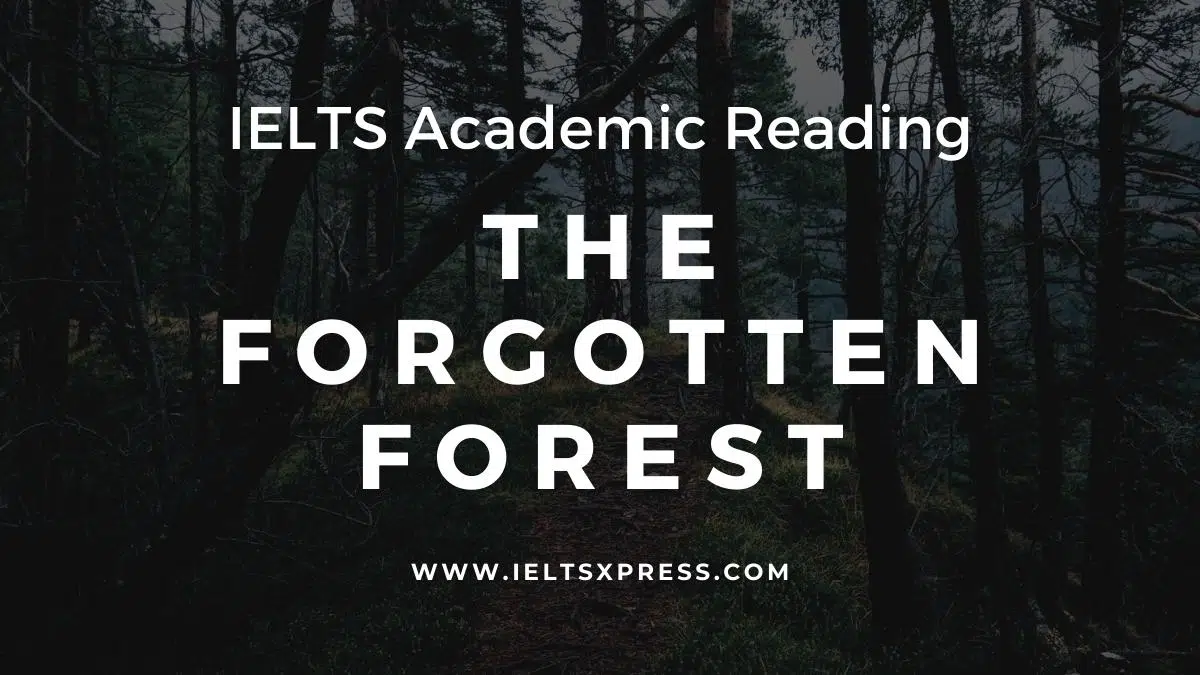The Forgotten Forest IELTS Reading Passage with Answers
Reading Passage 1
The Forgotten Forest
Found only in the Deep South of America, longleaf pine woodlands have dwindled to about 3 per cent of their former range, but new efforts are underway to restore them.
THE BEAUTY AND THE BIODIVERSITY of the longleaf pine forest are well-kept secrets, even in its native South. Yet, it is among the richest ecosystems in North America, rivalling tallgrass prairies and the ancient forests of the Pacific Northwest in the number of species it shelters. And like those two other disappearing wildlife habitats, longleaf is also critically endangered.
In longleaf pine forests, trees grow widely scattered, creating an open, park-like environment, more like a savanna than a forest. The trees are not so dense as to block the sun. This openness creates a forest floor among the most diverse in the world, where plants such as many-flowered grass pinks, trumpet pitcher plants, Venus flytraps, lavender ladies, and pineland big buttons grow. As many as 50 different species of wildflowers, shrubs, grasses, and ferns have been catalogued in just a single square meter.
Once, nearly 92 million acres of longleaf forest flourished from Virginia to Texas, the only place in the world where it is found. By the turn of the 21st century, however, virtually all of it had been logged, paved, or farmed into oblivion. Only about 3 per cent of the original range still supports longleaf forest, and only about 10,000 acres of that is uncut old-growth—the rest is a forest that has regrown after cutting.
Figuring out how to bring back the piney woods also will allow biologists to help the plants and animals that depend on this habitat. Nearly two-thirds of the declining, threatened, or endangered species in the southeastern United States are associated with longleaf. The outright destruction of longleaf is only part of their story, says Mark Danaher, the biologist for South Carolina’s Francis Marion National Forest. He says the demise of these animals and plants also is tied to a lack of fire, which once swept through the southern forests regularly. “Fire is absolutely critical for this ecosystem and for the species that depend on it,” says Danaher.
Name just about any species that occurs in longleaf, and you can find a connection to fire. Bachman’s sparrow is a secretive bird with a beautiful song that echoes across the longleaf Flatwoods. It tucks its nest on the ground beneath dumps of wiregrass and little bluestem in the open under-story. But once the fire has been absent for several years and a tangle of shrubs starts to grow, the sparrows disappear. Gopher tortoises, the only native land tortoises east of the Mississippi, are also abundant in longleaf. A keystone species for these forests, its burrows provide homes and safety to more than 300 species of vertebrates and invertebrates ranging from eastern diamond-back rattlesnakes to gopher frogs. If the fire is suppressed, however, the tortoises are choked out. “If we lose the fire,” says Bob Mitchell, an ecologist at the Jones Center, “we lose wildlife.’
Without fire, we also lose longleaf. Fire knocks back the oaks and other hardwoods that can grow to overwhelm longleaf forests. “They are fire forests,” Mitchell says. “They evolved in the lightning capital of the eastern United States.” And it wasn’t only lightning strikes that set the forest aflame. “Native Americans also lit fires to keep the forest open,” Mitchell says. “So did the early pioneers. They helped create the longleaf pine forests that we know today.”
Fire also changes how nutrients flow throughout longleaf ecosystems, in ways we are just beginning to understand. For example, researchers have discovered that frequent fires provide extra calcium, which is critical for egg production, to endangered red-cockaded woodpeckers. Frances James, a retired avian ecologist from Florida State University, has studied these small black-and-white birds for more than two decades in Florida’s sprawling Apalachicola National Forest. When she realised female woodpeckers laid larger clutches in the first breeding season after their territories were burned, she and her colleagues went searching for answers. “We learned calcium is stashed away in woody shrubs when the forest is not burned,” James says. “But when there is a fire, a pulse of calcium moves down into the soil and up into the longleaf.” Eventually, this calcium makes its way up the food chain to a tree-dwelling species of ant, which is the red-cockaded’s favourite food. The result: more calcium for the birds, which leads to more eggs, younger, and more woodpeckers.
Today, fire is used as a vital management tool for preserving both longleaf and its wildlife. Most of these fires are prescribed burns, deliberately set with a drip torch. Although the public often opposes any type of fire—and the smoke that goes with it—these frequent, low-intensity burns reduce the risk of catastrophic conflagrations. “Forests are going to burn,” says Amadou Diop, NWF’s southern forests restoration manager. “It’s just a question of when. With prescribed burns, we can pick the time and the place.”
Restoring longleaf is not an easy task. The herbaceous layer—the understory of wiregrasses and other plants, also needs to be re-created. In areas where the land has not been chewed up by farming but converted to loblolly or slash pine plantations, the seed bank of the longleaf forest usually remains viable beneath the soil. In time, this original vegetation can be coaxed back. Where agriculture has destroyed the seeds, however, wiregrass must be replanted. Right now, the expense is prohibitive, but researchers are searching for low-cost solutions.
Bringing back longleaf is not for the short-sighted, however. Few of us will be alive when the pines being planted today become mature forests in 70 to 80 years. But that is not stopping longleaf enthusiasts. “Today, it’s getting hard to find longleaf seedlings to buy,” one of the private landowners says. “Everyone wants them. Longleaf is in a resurgence.”
Questions 1-6
Choose NO MORE THAN TWO WORDS from the passage for each answer.
Write your answers in boxes 1-5 on your answer sheet.
Forest fire ensures that:
Birds can locate their 1_________ in the ground
The burrows of a species of 2________ provide homes to many other animals.
Hardwoods such as 3________ don’t take over.
Apart from fires lit by lightning:
Fires are created by 4_____ and settlers.
Fires deliberately lit are called 5________
Question 6-9
Complete the flowchart below.
Choose ONE WORD ONLY from the passage for each answer.
Write your answers in boxes 7-9 on your answer sheet.
How to increase the number of cockaded woodpeckers |
|---|
| Calcium stored in 6 ________ |
| Shrubs are burned. Calcium is released into 7___________ and travels up to the leaves. |
| a kind of 8 __________ eats the leaves. |
| Red-cockaded woodpeckers eat those a |
| The Number of 9 ___________ increases |
Questions 10-13
Do the following statements agree with the information given in Reading Passage 1? In boxes 10-13 on your answer sheet, write
TRUE if the statement is True
FALSE if the statement is false
NOT GIVEN If the information is not given in the passage
10 The sparse distribution of longleaf pine trees leads to the most diversity of species.
11 It is easier to restore forests converted to farms than forests converted to plantations.
12 The technology in recreating the herbaceous layer will phase out in the near future due to the high cost
13 Few people in this restoration program will see the replanted forest reach its maturity.
The Forgotten Forests IELTS Reading Answers
Practice with Expert IELTS Tutors Online
Apply Code "IELTSXPRESS20" To Get 20% off on IELTS Mock Test
1. NESTS
2. TORTOISES
3. OAKS
4. NATIVE AMERICANS
5. PRESCRIBED BURNS
6. SHRUBS
7. SOIL
8. ANTS
9. EGGS
10. TRUE
11. FALSE
12. NOT GIVEN
13. TRUE
ieltsxpress.com
Also Check: Homeopathy IELTS Reading Passage with Answers




